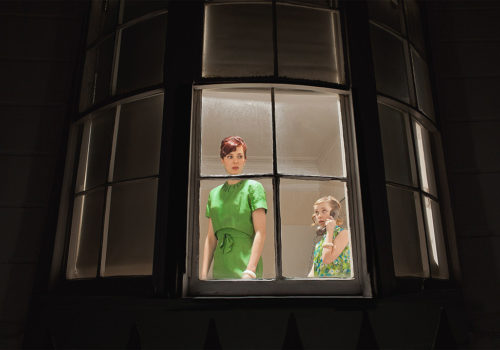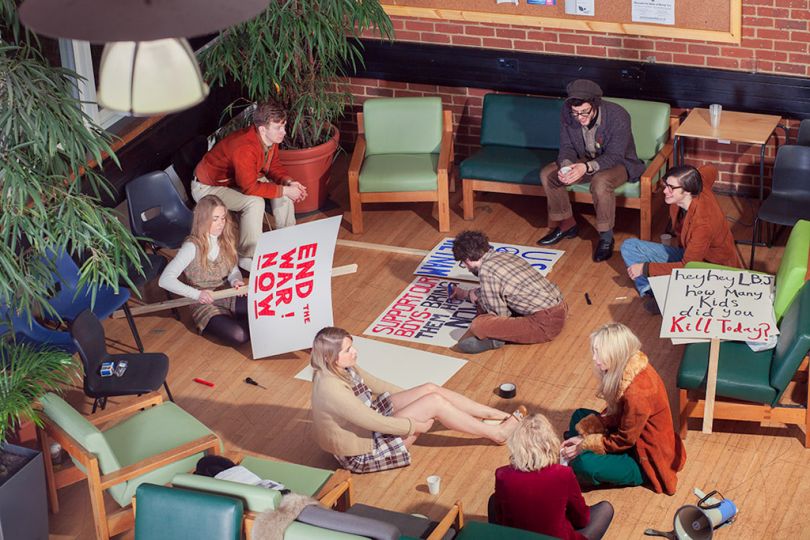Matt Henry photographs little stories inspired by the 60s and 70s like photographic ideograms. Three decades of an addiction to American cinema and television have led him to create a world where narrative fiction draws the viewer in.
Where does your photography come from ?
M. Henry : All my photography is shot in the UK. It’s American-inspired so I build sets using props I’ve sourced from America to recreate that US feel.
When is your decisive moment for taking photographs ?
M. H : My work is very staged so I don’t think decisive moment is a term that perhaps applies. There’s a harmony in the frame in terms of composition or colour that might encourage me to press the shutter, but I’ll examine the result and go back time and time again until I feel that I’ve got something right.
What inspired you work/your series ?
M. H : Each series is different but the overriding theme is the politics and culture of the USA, and most often during the period of 1960s and 1970s; it was a theme I focused on during my undergraduate degree in Political Theory. The 1960s as an integral point in our political history is of great interest to me; that all these movements arose in such a small space of time and fought and won the rights that we take for granted now. Free speech, civil rights, women’s rights; the right to argue that a government shouldn’t go to war in our name. Those movements got so far, then they kind of imploded and Nixon came to power. I’m working on long term projects that focus on these issues but so far I’ve only hinted at them in my work which has been based on the popular culture of that period, though I don’t think you can separate one from the other. Much of the cultural influences come from a diet of American films and television growing up as a kid and I think that eventually pushed my interests in the politics of the nation. I’m happy producing pop-style imagery, but like to explore some subjects in depth too. I’m currently working on an extended series about Hunter S Thompson during the period of the Watergate scandal. There’s a lot of research involved which I’m really getting into. After that’s finished I’ll probably shoot a few pretty pop pictures for relief!
What is the link between your commercial work and your personal work ?
M. H : One pays for the other! But I carry my style and my interest in narrative over to my commercial work. I’m interested in leaving traces of stories where possible that leave some sort of ambiguity to the reader. Viewers like to be challenged and they switch off when an image contains all the answers. So I try and push this approach in my commercial work when possible. Quite often I think people make the mistake of assuming that ad imagery has to provide everything immediately but some of the best ads have that ambiguity. You force people to think and it slows them down in front of your image. They have to give it more time. That can only be a good thing for advertising!
Which is a bigger priority for you : a great ad campaign or an exhibition at a famous gallery ?
M. H : I think anyone who says a great ad campaign should hang up their camera now, but I don’t have a lot of time for the big galleries either. They don’t really take many risks with their shows as they’re stuck in reliving the history of photography or fine art as created by a select group of academics and curators. There’s a lot more interesting works to be found in smaller galleries who can take more risks and get involved with contemporary work, or online of course. That’s the great thing about the internet; that is wrests some control from the gallery system and allows us all to be curators – the Tumblr generation who can simply say… I’ve seen this, it did something for me, take a look…
What are the current photographic trends for you ?
M. H : I don’t have any interest in stylistic trends but I think there’s a move away from realism and supposed ‘objective’ documentary practice towards fictional work with some sort of narrative. For me I think this work contains more honesty in lots of ways. It doesn’t pretend that the photographer isn’t in the equation. It says yes I’m here, I have a viewpoint, and this is my take on the world… this is what I want to communicate. There’s room for both approaches of course, but photography has been limited by its fixation on the real in the way that film hasn’t.
The world experience has changed drastically. Its representation has evolved. Has digital become inevitable in the photographic creative process ?
M. H :Film is still pushed in the universities, at least in the UK, but the debate doesn’t interest me much. I’m interested in telling a story, or communicating something. And I like to get there as quickly as possible so I can move onto the next, and digital allows me to do that. The medium doesn’t matter too much; paint, film, sculpture; as long as you’re able to say what you want with it! Based in Brighton, Matt Henry lives and works between Paris and London.
Interview by Séverine Morel
REPRESENTATION
London ; HORTON-STEPHENS – http://www.horton-stephens.com
Paris : ARTEM – http://www.artem-paris.com
GALLERY
ONE EYED JACKS – http://www.oneeyedjacksgallery.com

















